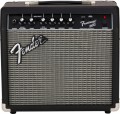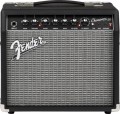Number of channels
The number of channels provided in a combo amplifier or a separate “head” (see “Type”).
This parameter is specified only if the device has
more than one channel. The channel in this case can be described as a kind of “path” for the audio signal, which has its own specific set of settings. If there are several such “paths,” then each of them can be configured at your discretion and you can switch between sound options with just one click of a button (in extreme cases, by switching the instrument to another input). The most typical example of using this function looks like this: one channel is used for clean sound, and the second is used for “overdrive” using the built-in distortion or overdrive (see “Effects”). Without channel separation, the sound would have to be changed either by reconfiguring the amplifier (setting the parameters again each time, which is simply inconvenient), or by using external “gadgets” (and this is not always the best option for a number of other reasons).
As for the number of channels, in multi-channel models there are most often just two of them - this gives the mentioned additional capabilities and at the same time does not particularly affect the cost of the device. This option is optimal for beginning musicians, but is also found in professional equipment. Increasing the number of channels makes it possible to provide more advanced options for preset settings (for example, “clean ringing”
..., “clean warm”, “Crunch” and “Overdrive”), but it significantly complicates and increases the cost of the design. Therefore, the higher this number, the fewer models with such characteristics are presented on the market. The maximum value found in modern guitar amplifiers is 6; a similar amount can be found in individual professional models, mainly with a digital element base (see “Type”).Equalizer
Type of equalizer provided in the device design
An equalizer allows you to change the volume of a separate part of the sound range (frequency band), thus changing the color of the entire sound. This is one of the most important functions related to audio settings; therefore, it can be provided directly in the guitar amplifiers themselves. And the type of equalizer is indicated by the number of bands available for adjustment.
The more of these bands, the more accurately you can adjust the sound, but the more complex and expensive the equipment becomes. In light of this, the simplest option involves only
2 bands - low and high frequencies; Often such an equalizer looks like two separate knobs for adjusting the bass and treble levels. At the same time, we note that similar functionality can be found in both budget and high-end guitar amplifiers: in the second case, it is assumed that if finer adjustments are needed, you can use external equipment. However,
three-band solutions (low, mid and high frequencies) are the most popular these days: such an equalizer provides quite extensive possibilities for adjusting the sound and is relatively inexpensive (and if finer adjustments are required, you can use external equipment).
4-band equalizers are noticeably less common, but are also quite popular (including in inexpensive devices); and some models provide
...5 or more (up to 12) adjustment bands.Analogue simulation
The presence of an analogue modeling function in the amplifier.
The meaning of this function lies in the fact that with the help of analogue sound processing, the amplifier changes the sound in a certain way, giving it one colour or another. So, many models provide modeling the sound of certain classical guitar amplifiers and/or cabinets; of course, there is no question of absolute similarity, but sometimes a copy can be almost indistinguishable from the original. Other models built on transistors (see "Type") can copy the sound of tube technology. And the analogue method of sound processing for such modeling was chosen because it allows you to do without unnecessary conversions (unlike digital); this has a positive effect both on the quality and atmosphere of the sound, and on the price and reliability of the equipment.
The specific features of analogue modeling in each case should be clarified separately, however, anyway, it significantly expands the functionality of the amplifier and provides additional features for fine-tuning the sound.
Effects
Built-in effects provided in the combo amplifier. You can also achieve various effects with the help of external “gadgets”, however, such gadgets need to be searched for and connected separately, while built-in effects are available immediately and without unnecessary settings.
—
Overdrive. Distortion in the form of a characteristic electric guitar "buzz" at low frequencies and "howl" at high frequencies, a little softer than distortion. Popular, in particular, in hard rock.
—
Distortion. Sufficiently hard and sharp distortion, similar in sound to overdrive, but more intense and brighter. It is widely used in various styles of metal, and is also found in rock.
—
Reverb. An effect based on simulating multiple decaying echoes from each sound. Depending on the duration and intensity of repetitions, it can give the sound a different colour. Used as an artistic device; among other things, it can create the effect that the guitar sounds in a certain room (concert hall, room with stone walls, an open area in the mountains, etc.). Note that the reverberation can be adjusted both by individual parameters (intensity, echo duration, etc.), and by selecting a preset set of parameters (for example, “sharp sound in the room” or “soft sound in the hall”).
—
Tremolo. Tremolo is basically a trembling effect that res
...ults from small and quick fluctuations in the volume of each note. Sometimes this term means vibrato (see below) — to the point that the manufacturers of guitar amplifiers themselves mean the effect of vibrato by the tremolo effect, and vice versa. So the specifics of this effect in each case should be clarified separately. Anyway, the tremolo can be "fixed" or adjustable in depth (range of volume change) and speed (jitter frequency).
— Vibrato. Another effect of "jerking" sound, which is often confused with tremolo (see above) — to the point that both these terms are used as identical. However, this is not true; the difference lies in the fact that vibrato is carried out due to the rapid fluctuations of the note not in volume, but in frequency. A similar effect can be achieved on the guitar itself by "pulsating" the strings, but using the amplifier's built-in instrument is much more convenient in most cases.
— Chorus. An effect designed to simulate the choral sound of an instrument. To do this, the amplifier copies the sound of the guitar and plays several copies simultaneously with the original signal, slightly shifting them in time (about 20 – 30 ms with a constant change) and frequency. However it is impossible to achieve a full-fledged choral sound in this way, but the effect is quite original in itself.
— Delay. A specific type of reverb (see "Reverb") that has become widespread as a separate effect. Delay simulates a clear single echo from the sound being played; for this, the original signal is copied and reproduced with a certain time delay (at least 50 ms).
In addition to those described above, other effects can be found in modern guitar combo amplifiers, in particular:
— Flanger. The effect is reminiscent of the whistle of a jet engine; it is often compared to a plane taking off. It is created similarly to the Chorus described above, differs from it in a shorter delay time and the presence of feedback.
— echo. Another kind of reverb, similar to delay (see “Delay”). It differs in that in this case the echo is reproduced repeatedly.
— Octaver. An effect in which a copy of it is added to the signal, shifted by an octave or two.
— Wah wah. An effect that produces a characteristic "croak" sound.Line input
The type of line input provided in the amplifier.
The line input is used to supply sound from an external source to a guitar amplifier (“amplifier” or “head”). In this case, the incoming audio signal is sent to the input of the power amplifier and through it to the built-in speaker or external cabinet. In any case, this function allows you to combine the “live” sound of the instrument with additional accompaniment: for example, you can connect a player with a recorded drum and bass part to the line input and learn the guitar part with accompaniment - or perform in a “one-man orchestra” format.
Different types of connectors can be used for line input:
— Mini-Jack (3.5 mm). A socket for a standard 3.5 mm mini-Jack plug. This interface is used mainly in portable audio equipment; Jack 6.35 mm and RCA are more popular in stationary devices.
— Jack (6.35 mm). A connector similar in design to the 3.5 mm mini-Jack and differing only in size. Actually, due to its size, this type of plug is practically never found in portable audio equipment, but is quite popular in stationary ones. Theoretically, a Jack type connector can be used for a balanced connection (see below), but in guitar combo amps a regular unbalanced input is more common.
- RCA. Connector for coaxial cable with tulip type plug. It is used exclusively in stationary audio equipment. A standard RCA input consists of two jacks (for
...stereo sound, left and right channel), but in guitar combo amplifiers there is only one connector, since there is no point in using stereo in this case - one channel is enough.
— Balanced XLR. The characteristic connector is round in shape with three contacts and is quite large in size. The term “balanced” describes the specifics of signal transmission: it is carried out not through two, as with a standard connection, but through three wires, two of which operate in antiphase. Due to this, most of the interference induced on the wire is extinguished by itself, without the use of any special filters, which allows the use of long cables without compromising signal quality. Balanced connections are found mainly in professional audio equipment. As with the RCA described above, the standard XLR input includes two jacks (stereo left and right), but guitar amps use a simplified, single jack version.
Some combo amplifiers are equipped with several types of line inputs at once - for example, Jack and RCA. This usually means having separate connectors for each type. Theoretically, multiple inputs allow you to simultaneously connect several signal sources, but in practice this possibility should be clarified separately.Headphones
The type
of headphone output provided in the design of the amplifier.
Headphones will be useful especially in a situation where you can not make noise — for example, when practicing the guitar at a late time. And the options for their connection can be as follows:
— Mini-Jack (3.5 mm). Output for a standard 3.5 mm mini-Jack plug. This plug is equipped with most modern headphones, especially entry-level and mid-range. However, in terms of the quality and reliability of the connection, it is noticeably inferior to the larger Jack 6.35 mm (see below), so it is relatively rare in combo amplifiers.
— Jack (6.35 mm). The connector is quite large, designed mainly for stationary audio equipment. As the main connection method, it is rarely found among headphones, these are mainly professional models. At the same time, you can connect headphones with a 3.5 mm mini-Jack connector to such a jack using a simple adapter (in many “ears” such adapters are even included in the standard package); and the connection itself is tight, reliable and with a minimum of interference from the point of contact. Due to this, most "amps" use this type of connector.

